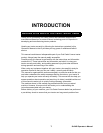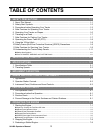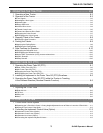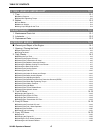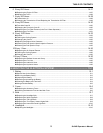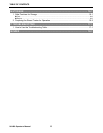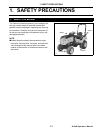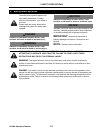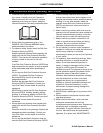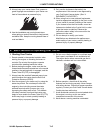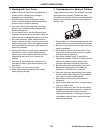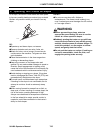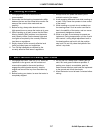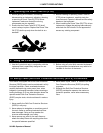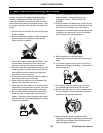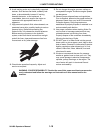
1-3
1. SAFETY PRECAUTIONS
Sc2400 Operator’s Manual
1. Understand the performance and limitations of
your tractor. Carefully study this Operator’s
Manual and learn the instructions in it before
operating or servicing your tractor. Keep the
Operator’s Manual in an easily accessible place.
2. Strictly follow the statements given in the
DANGER, CAUTION and WARNING safety
decals attached to the tractor.
3. For operator safety, always install the Roll-Over
Protective Structure (ROPS).
Keep the seat belt fastened while operating the
tractor with the Roll-Over Protective Structure
(ROPS). This practice will reduce the possibility
of injury or death in the event of roll-over
accident.
If the Roll-Over Protective Structure (ROPS) has
been removed for any reason, be sure to reinstall
all the associated parts before operating the
tractor.
Do not alter the Roll-Over Protective Structure
(ROPS). The altered Roll-Over Protective
Structure (ROPS) may fail to provide the
designed protection.
Replace the damaged Roll-Over Protective
Structure (ROPS) immediately. Contact your
local Cub Cadet Yanmar dealer for technical
assistance.
NEVER alter or repair the Roll-Over Protective
Structure (ROPS). Welding, bending, drilling,
grinding, or cutting may weaken the Roll-Over
Protective Structure (ROPS). Contact your local
Cub Cadet Yanmar dealer for technical
assistance.
4. Always fasten the seat belt while operating the
tractor with the Roll-Over Protective Structure
(ROPS).
Check the seat belt for any damage. Replace the
damaged seat belt immediately. Contact your
local Cub Cadet Yanmar dealer for technical
assistance.
Do not use the seat belt if the tractor does not
have the Roll-Over Protective Structure (ROPS).
5. Check overhead clearance carefully before
driving under power lines, wires, bridges or low
hanging tree branches, before entering or leaving
building, or in any other situation where the
operator and/or Roll-Over Protective Structure
(ROPS) may be struck, which could result in
serious injury.
6. Make sure that any person (other than a usual
operator) who will operate the tractor studies this
Operator’s Manual before operation. Know the
controls and how to stop the machine quickly.
7. Make sure that any person or obstacle is not
under or around the tractor before and during
operation. Be sure to maintain sufficient
overhead clearance above the tractor.
8. Do not operate your tractor and/or implement
installed to it while you are under the influence of
alcohol, drug, medicine or controlled
substance(s) or when you are not fit for operation
of your tractor.
9. For operation, wear close-fitting clothing. When
operating the tractor or working around the
tractor, do not wear loose-fitting clothes or
jewelry, or baggy or damaged clothing. When
caught by a moving part of the tractor, an
accident can result. Cut-off pants or shorts do not
provide protection against flying debris. Never
operate the tractor in bare feet, sandals, or
sneakers. Wear additional protections including
non-slip safety boots or shoes, and safety
goggles and gloves, etc. as appropriate or
required by currently applicable local laws and
regulations. Wear ear protection in a noisy
environment to prevent hearing damage and
reduce operator fatigue.
10. NEVER allow a passenger on any portion of the
tractor.
11. Remain seated in the operator’s station when
operating the tractor.
12. Make sure that the brakes, clutch and other
mechanical components are free from
misadjustment and excessive wear. Replace any
excessively worn or damaged component
immediately. At regular intervals, check that all
the nuts, bolts and screws are appropriately
tightened. (For details, see “MAINTENANCE”)
3. Precautions before Operating Your Tractor



